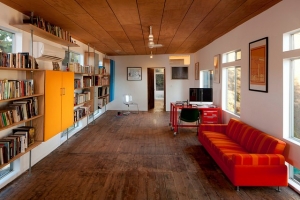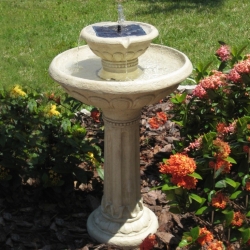
By Mary Bradford
June 8, 2015 (San Diego’s East County)--It was right after buying a new “fixer-upper” home that I realized a few things; I had an immense project on my hands, one that would include a great deal of buying, reusing, and inevitably discarding, because there were a number of details that prevented the new place from feeling like home. The other thing I realized was that trends were changing in the home-design industry, and that a bigger focus than ever was being put onto products that were energy efficient, environmentally conscious, and made with an intent focused on more than just aesthetics.
In terms of my own project, I didn’t need to think about more than floors and windows for the interior, and garden outside; so the majority of items I researched were focused in these areas. That’s not to say that there aren’t various other sustainable items available, just that I hope my findings help inspire other homeowners to start thinking in the same way.
There are steps being taken to “green” a home, that start at the very beginning in the building process, and continue on to the decorating and even landscaping. It’s a trend that has both builder and buyer in mind; one that reduces costs, but also takes into account unnecessary consumption of resources, and overall output of waste. According to Gary Wagner, CEO of Green Distribution, “green building will continue double digit growth,” noting an increase in the use of building products such as triple-glazed windows and internal lighting, as well as cosmetic features like flooring.
One of the most critical and noticed elements of any home is the floors; it’s the first thing people notice when they walk in, and other than actual structure it takes up the majority of interior space. Since there was old, and partially damaged wood flooring in my new home, it was my renovation starting point. What I found was that in an effort to follow the movement toward environmentally conscious products, a number of companies have begun offering flooring that is either reused or recycled from previous housing projects, or flooring made from materials that have been broken down and recycled from previous forms.
There are products as innovative as carpet made with fibers spun from corn, but even making the choice to buy used wood for flooring, rather than used, makes a difference. The products often look the same as new ones, and the pricing is often comparable - if not lower – when the item has been previously used. I wanted to stay with wood, so I decided to go the recycled route. I liked the rustic look of some of them, and intend to carry that theme throughout the rest of the design as well.
 Recycled wood can be used anywhere in a room to complete a look.
Recycled wood can be used anywhere in a room to complete a look.
Image courtesy of Jeremy Levine
Aside from products made with sustainability in mind, there are those available that help to save on energy while in use. I found products that help make the interior of the home more efficient, as well as those that take the idea outside, to encourage a greener garden, too. It’s the materials used, as well as the way in which their harnessed that really makes the difference over regular housing features.
Another important detail to take into account when personalizing a home is deciding on window treatments; it’s not only a choice in design, but one that effects the amount of light – and therefore heat – allowed into the space. Since my house came with bare windows, as most do, this was essential to address right away. I knew that there were specially made curtains designed to block out light, but the best ones I found are the made with heat in mind. By using a special coating, some companies have created blinds that can help regulate the temperature of a house throughout the year.
Keeping heat in for winter and out for summer is nice for creating a comfortable living environment, but even more important is the fact that it helps you use your heater less in the winter, and air conditioner in the summer. It helps to cut down on costs, and using energy means using less fossil fuels to supply the energy, which translates to less of a carbon footprint overall. It may not be a major step in the reduction of resource consumption, but it certainly helps to make a difference.
 Use window treatments to complement or contract the colors of a room.
Use window treatments to complement or contract the colors of a room.
Image courtesy of 247 blinds
Figuring out how to make my garden eco-friendly was a different kind of challenge; I had already chosen specific plants with water-reduction in mind, but I wanted to have a fountain. Outside of the home, the efforts seem less impactful; but if you plan on having water features as a part of a landscaping project, at least there are options that make them viable. For instance, there are fountains available, that use solar batteries rather than hardwired motors; which not only use virtually no energy at all, but allow you to place the fountain anywhere. Some of them include a feature that constantly recycles water as well, so that rather than hooking it up to a hose for water flow, it reuses it from a small basin inside.
Again, the reduction of cost and consumption on something like this might be minimal, but it’s the combination of items coming together than start helping. The reduction of water is especially important in areas facing extreme drought like California, where the conscious use of water is not only recommended, but essential for our future lifestyle.
 A water feature can add beauty to your yard, and is great for wildlife too.
A water feature can add beauty to your yard, and is great for wildlife too.
Image courtesy of Fountains.com
After realizing that replacing features in my new home would mean eventually being faced with the decision of what to do with the unwanted items, I took inspiration from the secondhand flooring I chose and researched areas to take the old products that were still in good condition. What I found was that in most areas, there are companies that not only take the old items from you, but pay to do so. I would have been happy with donating them, and if a local thrift store will take something I would encourage that decision instead, but either way it’s comforting to know that old floorboards or cabinets don’t have to be thrown away.
Deciding to replace a few things around my home in an effort to make it more sustainable feels good, and given renovation projects in the future I’ll likely do it again. Moving forward, eco-friendly homes won’t be an optional, but standard when it comes to building and designing. It makes sense for economic purposes, but more importantly it makes an effort at reducing the ever-growing footprint we leave on the Earth. Even if it’s just replacing something small, like a feature in your garden, I encourage you to go out and try to make at least one change; you might be surprised by what you find.
Mary Bradford is an active member of the real estate community with a background in journalism. She hopes to spread awareness about the realities of the housing market in order to help people find homes in order to start building their best life. When she’s not writing about real estate and home design, she can be found reading at the local coffee shop.










Recent comments